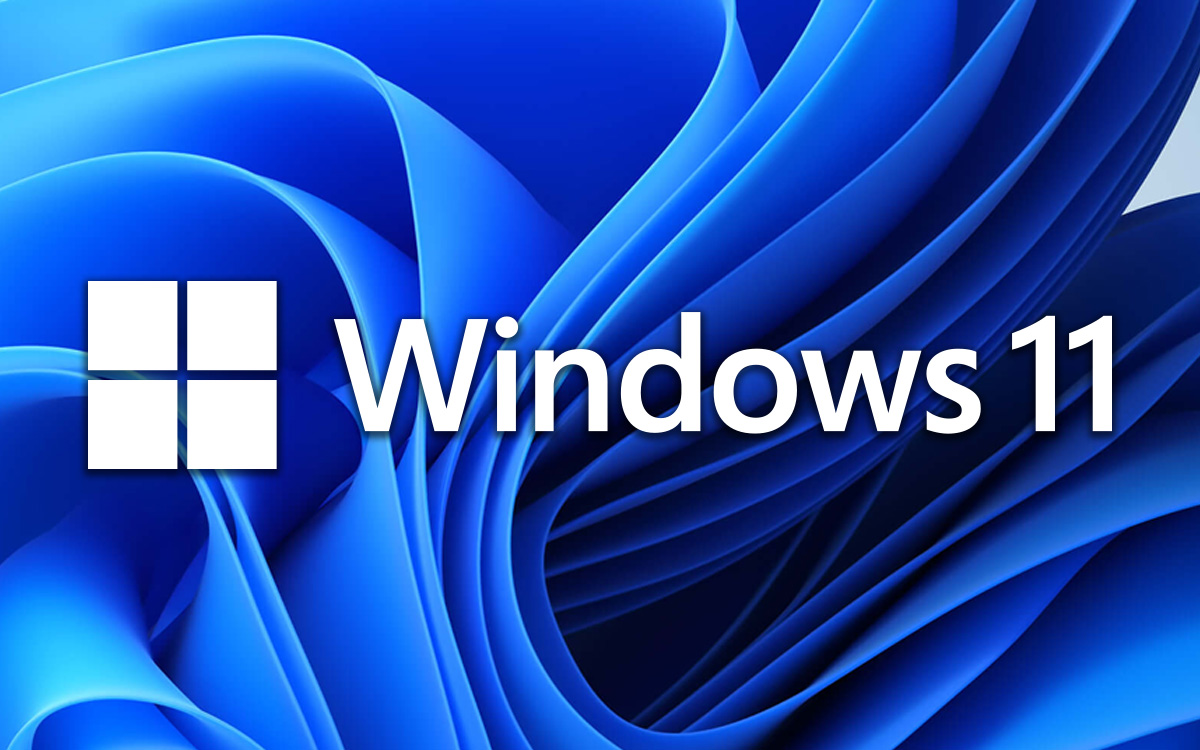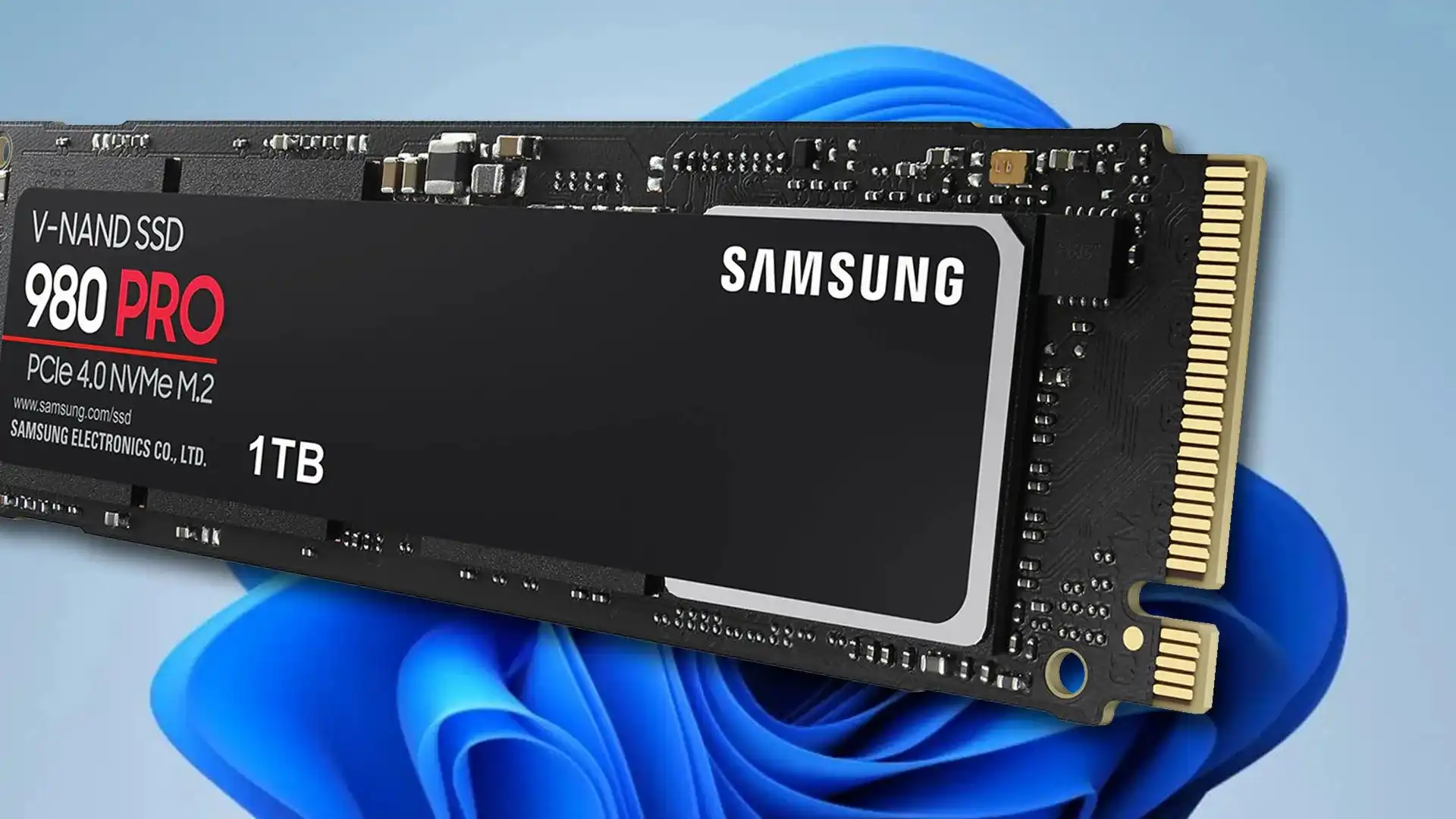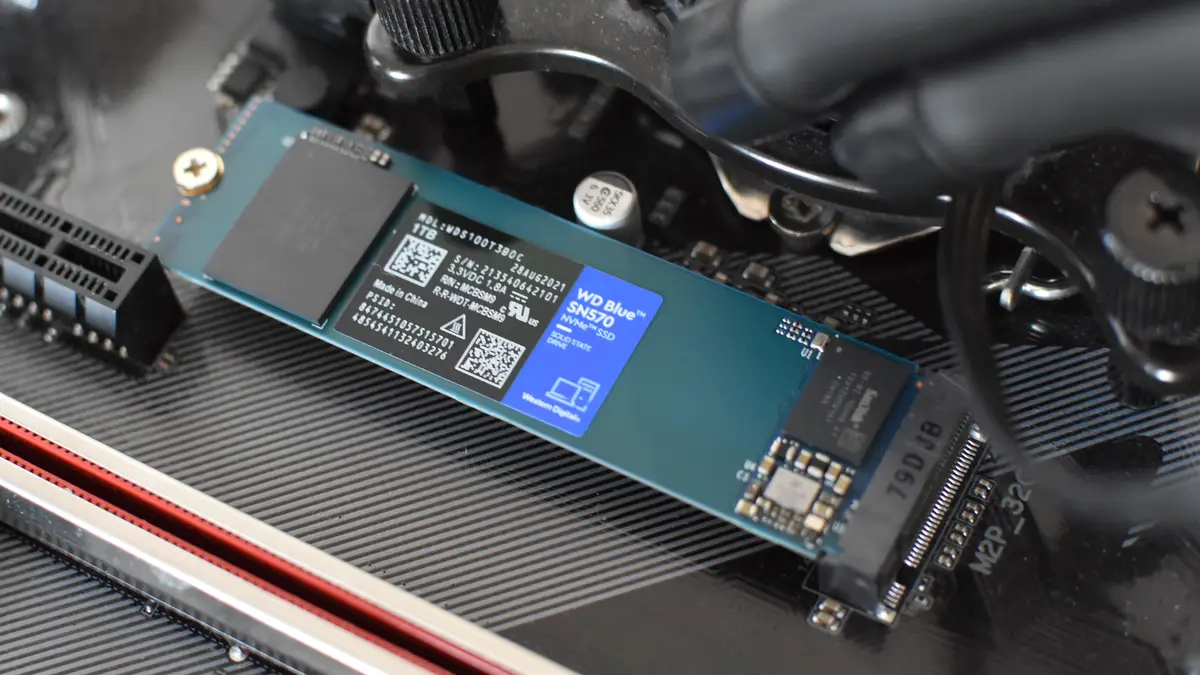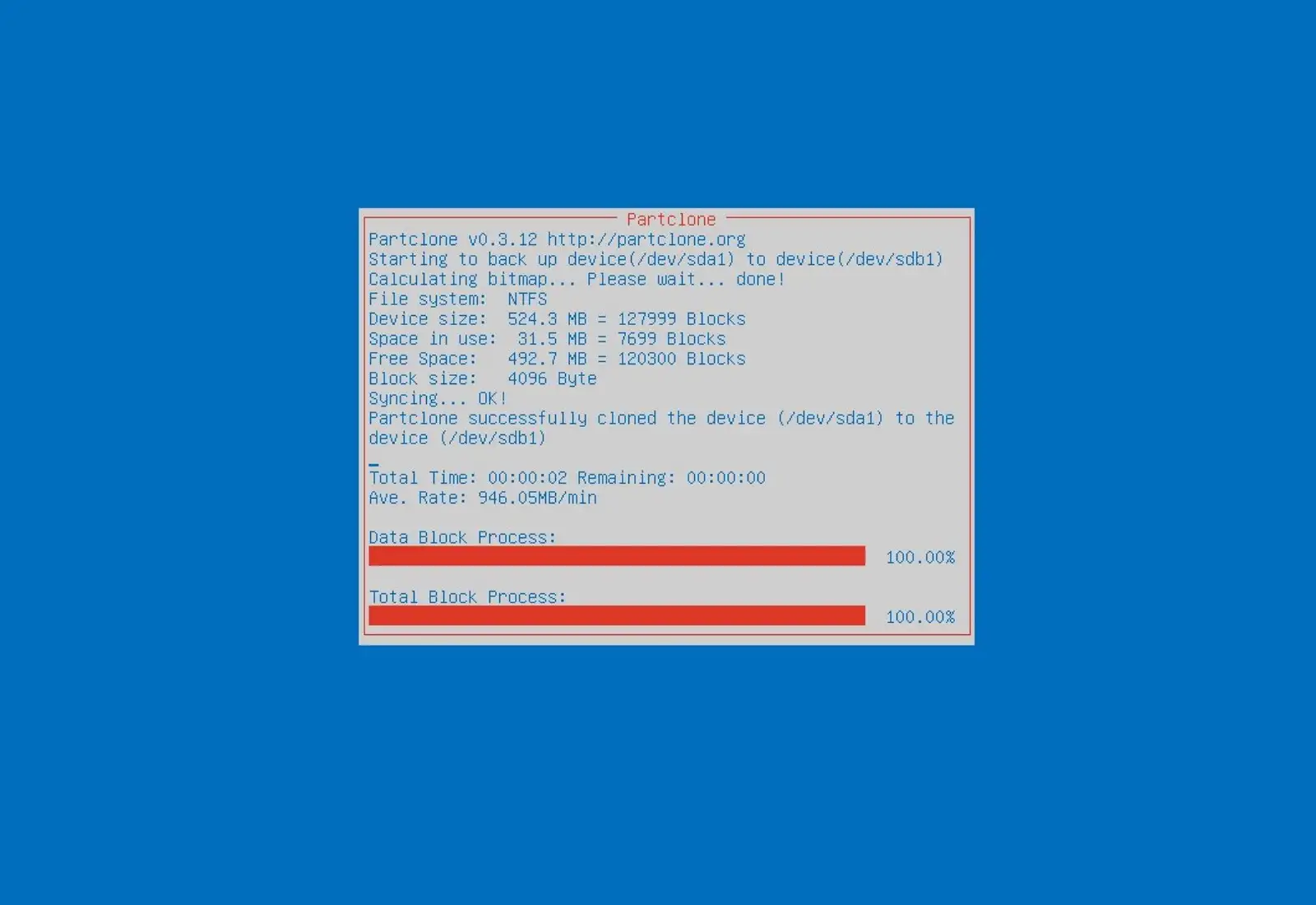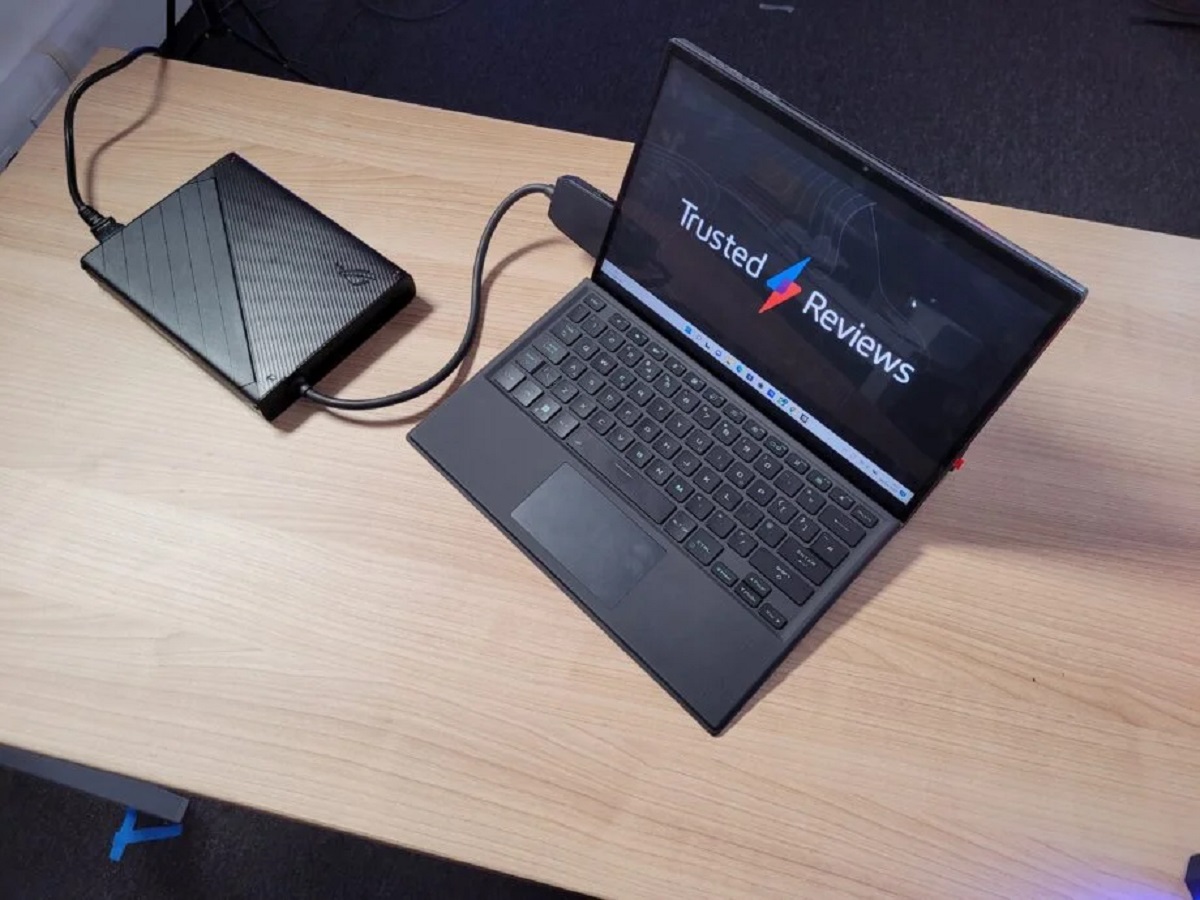Introduction
Welcome to the guide on how to install a new SSD (Solid State Drive) for your Windows 11 system. Upgrading your computer’s storage to an SSD can significantly improve its performance, speed, and overall user experience. Whether you’re a gaming enthusiast, a professional needing faster data access, or simply want to breathe new life into your aging computer, installing a new SSD is a fantastic investment.
An SSD differs from a traditional hard disk drive (HDD) by using flash memory to store data, resulting in faster boot times, quicker application loading, and improved file transfer speeds. With Windows 11 being the latest and greatest operating system from Microsoft, combining it with an SSD will provide you with an unbeatable computing experience.
In this guide, we’ll walk you through the step-by-step process of installing a new SSD on your Windows 11 system. We’ll cover everything from selecting the right SSD to transferring your data and installing the operating system.
But why exactly should you consider installing a new SSD? Let’s explore some compelling reasons:
1. Speed and Performance: SSDs offer significantly faster read and write speeds compared to traditional HDDs, resulting in faster boot times, reduced application load times, and improved overall system responsiveness.
2. Reliability: SSDs have no moving parts, making them less prone to mechanical failure and more durable in the long run. This reliability factor ensures your data is secure and your system remains stable.
3. Noise and Heat: SSDs produce less noise as they do not have any moving parts, and they generate less heat, leading to a cooler and quieter computing experience.
4. Energy Efficiency: SSDs consume less power compared to HDDs, which contributes to better battery life for laptops and reduces energy consumption for desktop systems.
5. Future-Proofing: Embracing the latest technology by installing an SSD ensures your system is ready for future software advancements, including demanding applications and operating systems.
Now that you understand the benefits of installing a new SSD, let’s proceed to the next section, where we discuss how to prepare for the installation process.
Reasons to Install a New SSD
Installing a new SSD (Solid State Drive) in your computer brings a host of benefits that significantly enhance your computing experience. Let’s delve into some compelling reasons why you should consider upgrading to an SSD:
1. Speed and Performance: One of the primary reasons to install an SSD is the remarkable boost in speed and performance it provides. SSDs utilize flash memory, eliminating the need for mechanical parts found in traditional hard disk drives (HDDs). This enables faster data access times, shorter boot-up periods, and quicker application loading, leading to a smoother and more responsive system overall.
2. Improved Productivity: With improved speed, an SSD accelerates your workflow by reducing waiting times for applications to launch, files to save, and documents to load. Whether you’re a professional working with resource-intensive software or a casual user multitasking between various applications, an SSD ensures a noticeable improvement in productivity and efficiency.
3. Enhanced Gaming Experience: Gamers, rejoice! Installing an SSD can significantly enhance your gaming experience. With faster load times, you can jump into your favorite games more quickly, reducing frustrating delays between levels and improving overall gameplay. SSDs also offer smoother performance during gameplay, eliminating lag and improving frame rates.
4. Reliable and Durable: Unlike traditional HDDs, SSDs have no moving parts, making them less susceptible to physical damage and mechanical failures. This increased reliability ensures your data remains safe and your system remains stable, even when subjected to shocks or vibrations. Additionally, SSDs are built to withstand higher temperature ranges, contributing to their durability.
5. Energy Efficiency: SSDs are not only faster, but they are also more energy-efficient compared to HDDs. With lower power consumption, SSDs help extend your laptop’s battery life, allowing you to work or play for longer periods without the need for frequent recharging. For desktop systems, an SSD can contribute to energy savings over time, reducing your carbon footprint.
6. Noise Reduction: SSDs operate silently as they do not have any moving parts. Unlike HDDs that emit noise when the disk spins, an SSD eliminates this source of sound, providing a noise-free computing experience. Whether you’re in a quiet library or working late at night, an SSD ensures a peaceful environment.
7. Upgradability and Future-Proofing: Installing an SSD future-proofs your system. As technology advances, software and applications become more resource-intensive. By upgrading to an SSD, you ensure your computer is equipped to handle demanding tasks and take full advantage of the latest software advancements without compromising performance.
With these compelling reasons in mind, it’s evident that installing a new SSD is a wise investment, offering tangible benefits in terms of speed, performance, reliability, and energy efficiency. Now, let’s move on to the next section to explore how to prepare for the installation process.
Preparing for the Installation
Before diving into the installation process of your new SSD, it’s crucial to adequately prepare to ensure a smooth and successful upgrade. Here are the essential steps to follow:
1. Back up Your Data: Prioritize backing up all your important files and data before making any changes to your system. While the installation process itself should not affect your existing data, it’s always better to be safe than sorry. Consider using an external hard drive, cloud storage, or a reliable backup software solution to create a complete backup of your files.
2. Determine Compatibility: Check your computer’s specifications and ensure that the new SSD you’re considering is compatible with your system. Confirm the form factor (2.5-inch, M.2, or PCIe), interface (SATA or NVMe), and capacity requirements. Consult your computer’s documentation or the manufacturer’s website for accurate information regarding compatibility.
3. Prepare Installation Tools: Gather the necessary tools for the installation process. You may need a Phillips-head screwdriver, an anti-static wrist strap, and any additional tools specific to your computer’s case design. Ensure you have a clean and well-lit workspace to perform the installation.
4. Update Firmware and Drivers: Before installing the new SSD, ensure that your computer’s firmware and drivers are up to date. Check the manufacturer’s website for the latest updates for your computer model. Updating firmware and drivers can enhance compatibility and improve performance with the new SSD.
5. Consider Cloning or Fresh Installation: Decide whether you want to clone your existing drive or perform a fresh installation of the operating system on the new SSD. Cloning allows you to transfer everything from your old drive to the new SSD, including the operating system, applications, and files. Fresh installation, on the other hand, provides a clean start but requires reinstalling the operating system and applications. Consider the pros and cons of each method based on your specific needs.
6. Allocate Time and Patience: Installing a new SSD requires time and patience. Allocate a sufficient amount of time for the entire process, including data backup, installation, and software setup. It’s crucial to take things slowly, follow the instructions carefully, and not rush through any steps. This will help ensure a successful installation without any issues.
Taking these preparatory steps will set you up for a successful SSD installation and help you avoid any potential headaches along the way. Once you’ve completed these preparations, you’re ready to move on to the next section, where we’ll guide you in choosing the right SSD for your needs.
Choosing the Right SSD
When it comes to selecting the right SSD (Solid State Drive) for your system, there are several factors to consider. The SSD you choose should align with your specific needs and requirements. Here are some key aspects to keep in mind during the selection process:
1. Form Factor and Interface: Determine the form factor and interface of the SSD based on your computer’s compatibility. Common form factors include 2.5-inch, M.2, and PCIe, while interfaces can be SATA or NVMe. Check your computer’s documentation or manufacturer’s website for the supported form factors and interfaces.
2. Storage Capacity: Consider the amount of storage space you need. SSDs are available in a range of capacities, from smaller sizes like 128GB or 256GB, up to larger capacities like 1TB or 2TB. Assess your storage requirements based on the type of files you work with, such as documents, photos, videos, or games.
3. Performance: Look for SSDs with high read and write speeds to ensure fast data transfer and improved system performance. Consider the SSD’s sequential read and write speeds, as well as its random read and write speeds. Higher performance SSDs deliver smoother operations and reduce loading times for applications.
4. Endurance and Reliability: Check the endurance rating and reliability features of the SSD. Look for SSDs with higher terabytes written (TBW) ratings, as these indicate a longer lifespan and higher durability. Additionally, features like error correction, wear leveling, and power loss protection contribute to enhanced reliability and data integrity.
5. Price and Budget: Set a budget for your SSD purchase and consider the price per gigabyte (GB). SSD prices have come down over the years, but larger capacity and higher-performance models can still be relatively expensive. Determine the balance between storage capacity, performance, and your budget to find the best SSD within your price range.
6. Brand and Warranty: Choose reputable SSD brands known for their quality and reliability. Popular brands often provide better customer support, firmware updates, and longer warranty periods. Take the time to research and read reviews to ensure you select an SSD from a reliable manufacturer.
7. Compatibility and Upgrade Options: Ensure the SSD is compatible with your computer’s operating system and hardware. Check the system requirements and compatibility details provided by the SSD manufacturer. Additionally, consider the upgrade options if you plan to expand your storage in the future. Some SSDs come with multiple slots or support for RAID configurations.
By considering these factors, you can make an informed decision when choosing the right SSD for your system. Take the time to research different options, read reviews, and compare specifications to find an SSD that meets your needs perfectly. With the SSD selected, you’re one step closer to enjoying the benefits of faster storage. In the next section, we’ll cover the crucial step of backing up your data before proceeding with the installation.
Backing Up Your Data
Prior to proceeding with the installation of your new SSD (Solid State Drive), it is crucial to prioritize backing up all your important data. While the installation process itself should not affect your existing data, unexpected issues can arise. By taking the time to back up your data, you can ensure its safety and peace of mind. Here are some essential steps to follow for a thorough data backup:
1. Identify Critical Data: Begin by identifying important files, documents, photos, videos, and any other data that you cannot afford to lose. This could include work-related documents, personal files, or media collections. Make a list or create a folder to keep track of the data you need to back up.
2. Choose a Backup Method: Determine the backup method that suits your needs. There are several options available, including external hard drives, cloud storage services, network-attached storage (NAS), or online backup solutions. Consider factors such as storage capacity, ease of use, and accessibility when selecting a backup method.
3. External Hard Drives: External hard drives provide a convenient option for backing up your data. Connect the external drive to your computer and copy your important files to the drive. Make sure you choose a drive with enough storage capacity to accommodate all your data.
4. Cloud Storage Services: Cloud storage services, such as Dropbox, Google Drive, or Microsoft OneDrive, offer secure and easily accessible storage for your data. Upload your important files to the cloud and ensure they are synced and backed up on the service’s servers. Some services offer a limited amount of free storage, while others may require a subscription fee for larger storage options.
5. Network-Attached Storage (NAS): If you have a NAS device on your network, you can use it to backup your data. NAS devices provide dedicated storage that is accessible from multiple devices on your network. Set up a backup job or configure automatic file synchronization to ensure your data is regularly copied to the NAS.
6. Online Backup Solutions: Online backup solutions, such as Carbonite, Backblaze, or Acronis True Image, offer comprehensive backup services. These providers offer secure encrypted backups over the internet, allowing you to restore your data from anywhere. Evaluate the pricing and features of different providers to choose the one that best fits your requirements.
7. Perform Regular Backups: Ensure that you regularly perform backups to keep your data up to date. Consider establishing a backup schedule, whether daily, weekly, or monthly, depending on the frequency of changes to your data. This practice minimizes the risk of data loss and ensures you have a recent backup readily available.
Remember: Always verify that your backups are successful and accessible. Take the time to test the restoration process to ensure you can recover your data when needed. This step is essential to avoid any unpleasant surprises or potential data loss during the SSD installation process.
Once you have completed the backup process and verified the accessibility of your important data, you are now ready to proceed with the installation of your new SSD. In the next section, we will guide you through the steps of shutting down and opening your computer in preparation for the installation.
Shutting Down and Opening Your Computer
Before you can install your new SSD (Solid State Drive), it’s essential to shut down your computer properly and open it up to access the internal components. The following steps will guide you through the process:
1. Save and Close any Running Programs: Save your work and close any open programs or applications that are currently running on your computer. This ensures that no unsaved data is lost during the shutdown process.
2. Shut Down Your Computer: Click on the Start button in the Windows taskbar and select the “Shut Down” option from the power menu. Alternatively, you can press the Windows key + X on your keyboard and choose “Shut down or sign out” followed by “Shut down.”
3. Unplug Power and Peripherals: Once your computer has shut down completely, unplug the power cord from the wall outlet. Next, disconnect any peripherals connected to your computer, such as monitors, keyboards, mice, and USB devices. This ensures safety and prevents any accidental damage during the process.
4. Ground Yourself and Use an Anti-Static Wrist Strap: To protect your computer’s components from static electricity, it’s important to ground yourself. You can do this by wearing an anti-static wrist strap or by continuously touching a grounded metal surface (such as the metal part of your computer case) to discharge any static buildup in your body.
5. Open Your Computer Case: Depending on your computer’s design, you may need to remove one or more screws or slide a latch to open the case. Refer to your computer’s manual or search online for specific instructions on how to open your particular computer model. Take your time and be gentle to avoid damaging any components.
6. Locate the Hard Drive Bays: Once your computer case is open, locate the hard drive bays. These are usually located at the front or side of the case and may be labeled. Some computer cases have removable drive cages, while others have dedicated slots or brackets for the drives.
7. Identify the Existing Hard Drive: Identify the existing hard drive where the operating system is currently installed. Make a note of the connections and cables attached to it, as you will need to disconnect and remove it later in the installation process.
8. Ensure Proper Ventilation: While your computer case is open, take the opportunity to ensure that there is proper ventilation and airflow. Clear out any accumulated dust or debris using compressed air or a soft brush. This helps to prevent overheating and ensures optimal performance of your computer system.
By following these steps, you have successfully shut down your computer and opened the case in preparation for the installation of your new SSD. In the next section, we will guide you through the process of mounting the SSD in your computer.
Mounting the SSD
Mounting the SSD (Solid State Drive) in your computer involves securing it properly within the case to ensure stability and proper functioning. Follow these steps to mount your new SSD:
1. Choose an Available Drive Bay: Identify an available drive bay in your computer case where you will install the SSD. If you have multiple drive bays, choose one that is convenient and easily accessible.
2. Prepare the Mounting Bracket: If your computer case requires a mounting bracket to secure the SSD, attach the bracket to the SSD using the provided screws. Ensure a snug fit and align the screw holes on the bracket with those on the SSD.
3. Secure the SSD in the Drive Bay: Gently slide the SSD or mounting bracket into the drive bay, aligning it with the screw holes on the case. Use the appropriate screws or clips to secure the SSD firmly in place. Ensure that it is flush with the case and properly seated.
4. Pay Attention to Cable Connections: Take note of the cables connected to the existing hard drive that you identified earlier. Carefully disconnect the necessary cables from the existing hard drive, keeping track of their positions to ensure correct reconnection later. These cables typically include the SATA data cable and the SATA power connector.
5. Connect Cables to the SSD: Connect the SATA data cable and SATA power connector to the corresponding ports on the SSD. Make sure the connections are secure and snug. Note that the connectors are designed to fit in one direction only, so align the pins correctly before applying gentle pressure to connect them.
6. Organize and Route Cables: Once the SSD is mounted and the cables are connected, carefully organize and route the cables within your computer case. Use cable ties or clips to secure the cables and ensure they do not impede airflow or come into contact with any fans or other components.
7. Double-Check Connections and Mounting: Before closing your computer case, double-check that all connections are secure and properly seated. Ensure that the SSD is firmly mounted in the drive bay and that there are no loose components or cables that could interfere with the installation process.
8. Close the Computer Case: Once you have verified the connections and mounting of the SSD, carefully close your computer case. Slide the case panels back into place and secure them using the appropriate screws or latches. Ensure that all screws are tightened securely, but be cautious not to overtighten.
By following these steps, you have successfully mounted the SSD in your computer case. The next section will guide you through the process of connecting the SSD to the appropriate ports on your computer’s motherboard and formatting the drive.
Connecting the SSD
Connecting the SSD (Solid State Drive) to your computer involves ensuring proper data and power connections to enable communication between the drive and your system. Follow these steps to connect your SSD:
1. Locate the SATA Ports: Locate the SATA ports on your computer’s motherboard. These ports are usually labeled and can be found near the drive bays or along the edge of the motherboard.
2. Connect the SATA Data Cable: Take the SATA data cable that came with your SSD and connect one end to the SATA port on the motherboard. Align the connectors and gently insert the cable into the port. Ensure a snug fit, but avoid using excessive force.
3. Connect the SATA Power Cable: Use a SATA power cable from your computer’s power supply unit (PSU) to connect to the SSD. The SATA power connector has a unique L-shape and should fit easily into the corresponding socket on the SSD. Ensure a secure connection.
4. Check Connections and Cable Routes: Double-check that both the SATA data cable and power cable are securely connected to the SSD and the motherboard. Verify that the cables are properly routed and not blocking any airflow within the computer case.
5. Secure Cables: Once the connections are confirmed, use cable ties or clips to secure the cables and prevent them from coming loose or interfering with other components. Ensure that the cables are tidy and organized to promote better airflow and system maintenance.
6. Power On Your Computer: With the SSD properly connected, power on your computer. The system should recognize the SSD, and it will appear as a new storage device within the operating system.
7. Verify SSD Detection: After your computer has booted up, check if the SSD is detected in the BIOS or Disk Management. Enter the BIOS by pressing the specific key during the system startup (common keys include Del, F2, or F12), and navigate to the storage settings to confirm the presence of the SSD. In the operating system, open Disk Management to ensure the SSD is listed as a recognized drive.
8. Install SSD Manufacturer’s Software: If provided, consider installing any software or utilities provided by the SSD manufacturer. These tools can help monitor the drive’s health, upgrade firmware, or optimize its performance.
By following these steps, you have successfully connected your SSD to your computer, allowing for data transfer and communication between the drive and your system. In the next section, we will guide you through the process of formatting the SSD in preparation for installing Windows 11.
Formatting the SSD
Before you can install the operating system on your newly connected SSD (Solid State Drive), it’s essential to format the drive to ensure it is compatible with your computer. Follow these steps to format your SSD:
1. Open Disk Management: In Windows, right-click on the Start button and select “Disk Management” from the context menu. Disk Management is a built-in utility that allows you to manage and format storage devices.
2. Locate the SSD: Within the Disk Management window, locate the SSD. It should be listed as a new, unformatted drive. Take note of the disk number assigned to the SSD to avoid formatting the wrong drive.
3. Initialize the SSD: Right-click on the SSD and select “Initialize Disk” from the context menu. In the initialization dialog, choose the partition style for the drive. Most modern SSDs should use the “GPT (GUID Partition Table)” option. Click “OK” to proceed.
4. Create a New Partition: Right-click on the unallocated space of the SSD and select “New Simple Volume” from the context menu. In the New Simple Volume Wizard, follow the on-screen instructions to configure the partition size, assign a drive letter, and choose the file system (NTFS is recommended for Windows). Complete the wizard to create the partition.
5. Format the Partition: After creating the partition, right-click on it and select “Format” from the context menu. In the Format dialog, choose the desired file system, set a volume label (optional), and select quick format for faster processing. Click “OK” to start the formatting process.
6. Wait for Formatting to Complete: The formatting process may take some time, depending on the size of the SSD and your computer’s performance. The progress will be displayed, and once completed, the SSD will be ready for use.
7. Verify the Formatted SSD: After formatting, the SSD will appear as a healthy, formatted drive in Disk Management. It will also be accessible within the File Explorer under the assigned drive letter. Take a moment to confirm that the SSD is correctly formatted and ready for the operating system installation.
8. Ensure Proper Drive Letter Assignment: If necessary, you can change the drive letter assignment for better organization. Right-click on the SSD partition in Disk Management, select “Change Drive Letter and Paths,” and choose the desired letter.
By following these steps, you have successfully formatted your SSD, preparing it for the installation of the operating system. In the next section, we will guide you through the process of installing Windows 11 on your newly formatted SSD.
Installing Windows 11 on the SSD
Now that you have properly formatted your SSD (Solid State Drive), it’s time to install the operating system. Follow these steps to install Windows 11 on your SSD:
1. Prepare Windows 11 Installation Media: Download the Windows 11 installation files from the official Microsoft website or create a bootable USB drive with the Windows 11 installation files using the Windows Media Creation Tool.
2. Insert the Installation Media: Insert the bootable USB drive or DVD into your computer’s USB port or optical drive. Ensure that the SSD is connected to your computer as the primary storage device.
3. Restart Your Computer: Restart your computer and enter the BIOS or UEFI settings by pressing the specific key during system startup (common keys include Del, F2, or F12). In the BIOS/UEFI settings, set the boot priority to prioritize the installation media (USB or optical drive) as the primary boot device.
4. Save Changes and Exit BIOS: Save the changes in the BIOS/UEFI settings and exit. Your computer will restart and boot from the installation media.
5. Follow the Windows 11 Installation Wizard: Once the computer boots from the installation media, follow the on-screen prompts to begin the Windows 11 installation process. Select the desired language, time zone, and keyboard layout when prompted, and click “Next” to proceed.
6. Enter Product Key and Accept License Terms: If prompted, enter your Windows 11 product key. If you’re reinstalling Windows 11 on the same computer, you can skip this step. Read and accept the license terms to continue.
7. Choose Custom Install: When prompted to choose the type of installation, select “Custom: Install Windows only (advanced)” to perform a clean installation. This allows you to select the SSD as the installation destination.
8. Select the SSD as the Installation Destination: In the drive selection screen, choose the SSD as the destination where you want to install Windows 11. Ensure that you select the correct drive to avoid accidental data loss on other drives. Click “Next” to proceed.
9. Wait for the Installation to Complete: Windows 11 will now begin the installation process on the selected SSD. The installation time may vary depending on your computer’s hardware and the installation media’s speed. Follow the on-screen instructions and wait for the installation to complete.
10. Set Up Windows 11: Once the installation is finished, Windows 11 will restart your computer. Follow the prompts to personalize your settings, including signing in with your Microsoft account, configuring privacy preferences, and customizing the desktop environment.
11. Install Device Drivers and Updates: After setting up Windows 11, ensure that you install the latest device drivers and updates for optimal performance and compatibility. Visit the manufacturer’s website for your computer model or use Windows Update to download and install the necessary drivers and updates.
By following these steps, you have successfully installed Windows 11 on your newly formatted SSD. You can now enjoy the benefits of the latest operating system on your upgraded system. In the next section, we will discuss optimizing Windows 11 for optimal performance with your SSD.
Optimizing Windows 11 for the SSD
After installing Windows 11 on your SSD (Solid State Drive), it’s important to optimize the operating system to maximize the performance, longevity, and efficiency of your SSD. Follow these steps to optimize Windows 11 for optimal SSD usage:
1. Enable TRIM: TRIM is a feature in Windows that helps maintain the performance of your SSD over time. To enable TRIM, open the Command Prompt as an administrator and type the following command: fsutil behavior set disabledeletenotify 0. Press Enter to execute the command.
2. Disable Indexing: Since SSDs have fast access times, you can improve overall performance by disabling indexing. Open File Explorer, right-click on your SSD drive, select “Properties,” and uncheck the “Allow files on this drive to have contents indexed…” option. Click “Apply” and “OK” to save the changes.
3. Disable Hibernation: Hibernation can take up valuable storage space on your SSD. If you don’t use hibernation and want to free up space, open the Command Prompt as an administrator and type powercfg /h off. Press Enter to disable hibernation and reclaim disk space.
4. Adjust Power Options: Optimize power settings to strike a balance between performance and power consumption. Open the Start menu, search for “Power & sleep settings,” and click on the search result. From there, customize the power plan settings to optimize SSD performance while conserving energy.
5. Disable Superfetch and Prefetch: Disable Superfetch and Prefetch, which are designed to improve system performance on traditional hard drives but can consume unnecessary resources on an SSD. Open the Start menu, search for “Services,” and open the Services app. Locate “Superfetch” and “Prefetch” in the list, right-click on each, select “Properties,” and set the startup type to “Disabled.” Click “Apply” and “OK.”
6. Adjust Pagefile Settings: SSDs handle virtual memory efficiently, so you can optimize pagefile settings. Open File Explorer, right-click on “This PC,” select “Properties,” click on “Advanced system settings,” go to the “Advanced” tab, and click on “Settings” under the “Performance” section. In the Performance Options window, go to the “Advanced” tab, click on “Change” under the “Virtual memory” section, and uncheck “Automatically manage paging file size for all drives.” Select your SSD drive, select “Custom size,” and set both the initial and maximum size to the same value (recommended value is typically double the amount of RAM installed). Click “Set” and then “OK” to apply the changes.
7. Update SSD Firmware: Check the manufacturer’s website for firmware updates specific to your SSD. Keeping the firmware up to date ensures compatibility, stability, and potential performance improvements. Follow the manufacturer’s instructions to update the SSD firmware.
8. Regularly Update Windows 11: Stay up to date with the latest Windows 11 updates. Microsoft releases updates that may address performance issues, security vulnerabilities, and optimize compatibility with hardware and software. Keep your system updated by enabling automatic updates or manually checking for updates regularly.
By following these optimization steps, you can ensure that Windows 11 is fully optimized for your SSD, maximizing its performance, longevity, and efficiency. Enjoy the fast and reliable experience that your SSD has to offer.
Conclusion
Congratulations! You have successfully learned how to install a new SSD (Solid State Drive) and optimize Windows 11 for optimal performance on your computer. By upgrading to an SSD, you have unlocked a world of benefits, including faster boot times, improved application loading speeds, and enhanced overall system responsiveness.
Throughout this guide, we discussed the importance of preparing for the installation, choosing the right SSD, backing up your data, and opening your computer to access the internal components. We then guided you through the steps of mounting the SSD, connecting it properly, formatting the drive, and installing Windows 11. Finally, we covered the process of optimizing Windows 11 for your SSD’s maximum efficiency.
Remember, regular maintenance and care for your SSD are essential to maintain its performance and longevity. Stay up to date with firmware updates, keep your operating system and drivers updated, and periodically perform health checks on your SSD to ensure it is running smoothly.
We hope this guide has empowered you to confidently install a new SSD and optimize Windows 11 for the best performance. Enjoy the speed, reliability, and improved computing experience that your SSD brings.
If you have any further questions or need assistance, consult the documentation provided with your SSD or reach out to the manufacturer’s support for additional guidance. Enjoy your new SSD-enhanced system!







